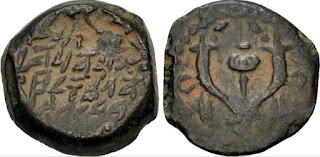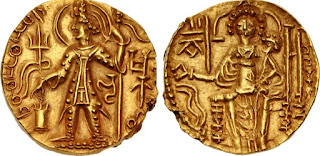Rome's territorial conquests were synonymous with their expansion. These conquests were celebrated with magnificent displays like construction of monuments and mass celebrations. However, as not everyone lived in the capital or in major cities, the most efficient way to exhibit the achievements was through coinage. Coins could reach all parts of the Empire, allowing the population to familiarize with both the emperor and the conquests. While all the coins minted in Imperial Roman Empire played a role in promoting the emperor and his policies, the coins celebrated their conquests. These coins through carefully choosing both the sides of the coins, spoke the tale about Rome's triumph and superiority across the world.
Aegypto Capta. These were the first Roman coins of conquest.
Augustus, Denarius, silver, 28 BC, weight 3.6 gm, Obverse: Head of Augustus, right with inscription CAESAR COS (VI), Reverse: Crocodile standing right with inscription AEGVPTO CAPTA
The rich and powerful, ancient Egypt was a temptation for any conqueror. Romans had their plans on the ''gift of the Nile''. The weakening of the Ptolemaic Empire brought Rome closer to Egypt. Julius Caesar's death, led to the last war of the Roman Republic, between Mark Antony and Octavian. After the Battle of Actium in 31 BC, Antony and Cleopatra committed suicide, leaving Octavian the sole ruler of the Roman world, and an emperor, Augustus. To mark this conquest, a series of gold and silver coinage was issued. The coin bears the ruler's portrait on the obverse and a crocodile (the Nile crocodile was a symbol of ancient Egypt) on the reverse, with AEGVPTO CAPTA (Egypt Captured) clearly visible.
Dupondius minted in Nemausus city, with joint portraits of Augustus and Agrippa and crocodile tied to a palm branch on reverse, 9-3 BC, copper alloy, weight 13.1 gm with inscriptions IMP DIVI F on Obverse and COL NEM on Reverse.
Asia Recepta. Taking back Anatolia.
Augustus, Quinarius, 29-27 BC, silver, Italy minted, weight 1.8 gm, Obverse: Augustus with inscription CAESAR IMP VII, Reverse: Victoria standing above the cista mystica, represents Augustus's victory over Mark Antony, legend ASIA RECEPTA, means Asia recovered.
Among Mark Antony's former territories that came under Augustus's control was Anatolia, a wealthy and urbanized region full of towns that traced their origins to the Classical Greek period or beyond. Although this area was an integral part of Roman territory since 63 BC, yet Augustus, he decided to commemorate his takeover of Asia Minor with the special issue of a small Roman coin. The motif chosen was ''cista mystica'' flanked by two serpents and topped by the figure of victory. The cista mystica, the sacred casket containing a live snake, was a ritual object used in secret rites of Dionysus and was adopted by many Asian cities on their coins. The appearance on the Roman coins guaranteed the preservation of the Hellenistic town's rights and custom and a prosperous future under the new ruler.
Vespasian, 69-79 AD, weight 25.4 gm, Obverse: Laureate head of Vespasian right with inscription IMP CAES VESPIAN AVG PM TR P P P COS, Reverse: IVDAEA CAPTA, C in exergue, emperor in military attire, standing right, resting foot on helmet set on ground, holding spear and parazonium, before him, palm tree beneath which Judaea seated right resting head on hands, in mourning
In August 70 AD, Roman legions stormed the Temple in Jerusalem, where the last rebel defenders of the city held out. The Jewish revolt was crushed. The Temple treasury had accumulated gold and silver for centuries, and the rich spoils of Jerusalem paid for the construction of the Colosseum in Rome. Emperor Vespasian's victory in the Jewish war is a major theme in coinage of his reign (69-79 AD) and that of Titus (71-81 AD).
Parthia Capta. Triumph in the East.
Trajan, Aureus, 114 AD, gold, weight 7.4 gm, Obverse: Bust of Trajan draped and cuirassed, with inscription IMP CAES NER TRAIANO OPTIM AVG GER DAC PARTHICO, translation, supreme commander Caesar, Nerva Trajan, best emperor (Augustus) conqueror of the Germans, conqueror of the Dacians, conqueror of the Parthians Reverse: Trophy between two Parthians seated left and right on ground, lettering and translation : High priest holder of tribunician power, consul for the sixth time, father of the nation, the senate and the Roman people, conquest of Parthia
There was one adversary Rome considered almost as an equal and that was Persia. Most would be conquerors found their doom after attacking Persia. One of the few Roman leaders who waged a successful campaign in the East was Emperor Trajan in his 115-117 AD campaign. Trajan captured territory till the shores of the Persian Gulf. To commemorate this achievement, he issued a special gold coin minted in 116 AD. However, Parthia would eventually recover continuing to trouble Rome for more than another century before being replaced by an even more dangerous Sassanid Empire.
Dacia Capta. Across the Danube.
Under Trajan, the Roman Empire reached its greatest territorial extent. Trajan's campaign over the Danube got Rome new territory and gold mines of Dacia (modern day Romania). The conquest of Dacia, 101-102 BC and 105-106 BC was the last major territorial gains for the Romans. Although, the famous Trajan's Column was erected as a monumental pillar, coinage was minted too. Although several versions of the image were minted, the most powerful motif is the mourning personification of Dacia, seated on a pile of captured weapons.
Germania Capta. An Imaginary Conquest.
Domitian, 87 AD, bronze weight 27 gm, Obverse: Bust of Domitian, laureate, right with aegis, lettering translated to, Supreme commander, Caesar, Domitian, emperor (Augustus), Conqueror of the Germans, consul for the 13th time, censor for life, father of the nation, Reverse: Trophy flanked on left by Germania seated left, head on arm and on right by German captive standing right, head left, left hand on shield
For centuries, the Danube and Rhine Rivers formed the borders of the Roman Empire and across the waters were the area inhabited by the barbarian tribes, who periodically invaded the imperial lands. Whenever, Rome tried to push the boundary over the Rhine River, the result was a disaster. The area across was known as Germania Magna. While the Imperial army tried many times, these were punitive actions. However even a minor victory would have been good for propaganda. In 83 AD, Emperor Domitian led a military expedition into the Black Forest region. Little is known of his campaign and probably no territory was annexed, yet the emperor decided to commemorate the occasion. The Roman coin bears the legend GERMANIA CAPTA (Germania Captured)
Sarmatia Devicta. The last Roman coin of conquest.
Constantine I, Nummus, Sirmium, 324-325 AD, weight 3.2 gm, Obverse: Laureate head right, Reverse: SARMATIA DEVICTA, Victory advancing right, holding trophy and palm branch and spurning captive on ground to right
Instead of conquests, the third century saw Rome fighting for survival. ''The Third Century Crisis'' was a time when Rome was fighting external and internal enemies Emperor Aurelian unified the entire Roman Empire. The fourth century empire celebrated by issuing a coin in 323 AD, for conquest in the Western part of the empire. The bronze coin bearing the legend SARMATIA DEVICTA (Sarmatia Conquered) denotes victory of emperor Constantine over Sarmatians and the annexation of territory on the other side of Danube River. However, the area was soon abandoned as the open steppe was difficult to defend.
Emperors continued to celebrate victories on coinage till the fall of the Roman Empire


















































